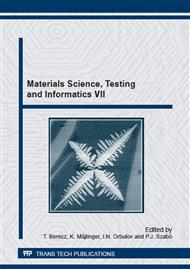[1]
S.P. Yu, H.J. Lin, M.H. Hon, Effects of process parameters on the soldering behavior of the eutectic Sn–Zn solder on Cu substrate, J. Mater. Sci. 11 (2000) 461–471.
Google Scholar
[2]
R.A. Islam, Y.C. Chan, W. Jillek, S. Islam, Comparative study of wetting behaviour and mechanical properties (microhardness) of Sn–Zn and Sn–Pb solders, Microelectron. J. 37 (2006) 705–713.
DOI: 10.1016/j.mejo.2005.12.010
Google Scholar
[3]
E. Çadırlı, U. Böyük, S. Engin, H. Kaya, N. Maraslı, A. Ülgen, Experimental investigation of the effect of solidification processing parameters on the rod spacings in the Sn–1. 2 wt. % Cu alloy, J. Alloys Compd. 486 (2009) 199–206.
DOI: 10.1016/j.jallcom.2009.07.027
Google Scholar
[4]
L.R. Garcia, W.R. Osório, L.C. Peixoto, A. Garcia, Mechanical properties of Sn–Zn lead-free solder alloys based on the microstructure array, Mater. Charact. 61 (2010) 212–220.
DOI: 10.1016/j.matchar.2009.11.012
Google Scholar
[5]
Yanxia Jing, Guangmin Sheng, Guoji Zhao, Influence of rapid solidification on microstructure, thermodynamic characteristic and the mechanical properties of solder/Cu joints of Sn–9Zn alloy, Materials and Design 52 (2013) 92–97.
DOI: 10.1016/j.matdes.2013.05.011
Google Scholar
[6]
Seo SK, Kang SK, Shih DY, Lee HM. An Investigation of Microstructure and Microhardness of Sn-Cu and Sn-Ag Solders as Functions of Alloy Composition and Cooling Rate, J Electron Mater 2009; 38(2): 257–65.
DOI: 10.1007/s11664-008-0545-x
Google Scholar
[7]
Bastow E. Solder families and how they work. Adv Mater Process 2003; 3: 26–9.
Google Scholar
[8]
Tamás Hurtony, Attila Bonyár, Péter Gordon, Gábor Harsányi, Investigation of intermetallic compounds (IMCs) in electrochemically stripped solder joints with SEM, Microelectronics Reliability 52 (2012) 1138–1142.
DOI: 10.1016/j.microrel.2011.12.035
Google Scholar
[9]
A. Bonyár. T. Hurtony, P. Gordon, G. Harsányi Selective electrochemical etching for the investigation of solder joint microstructures, 35th International Spring Seminar on Electronics Technology. Salzburg, Ausztria, (IEEE), o. 1-7.
DOI: 10.1109/isse.2012.6273114
Google Scholar
[10]
Tamás Hurtony, Attila Bonyár, Marco Luniak, Maik Müller, Determination of the Sn/IMC ratio in solder joints combining electrochemistry and confocal microscopy. In: Proc. of the 18th International Symposium for Design and Technology of Electronics Packages. Alba Iulia, Románia, pp.81-84.
DOI: 10.1109/siitme.2012.6384351
Google Scholar
[11]
Wislei R. Osório, Emmanuelle S. Freitas, José E. Spinelli, Amauri Garcia, Electrochemical behavior of a lead-free Sn–Cu solder alloy in NaCl solution, Volume 80, March 2014, Pages 71–81.
DOI: 10.1016/j.corsci.2013.11.010
Google Scholar
[12]
Wislei R. Osório, Leonardo R. Garcia, Leandro C. Peixoto, Amauri Garcia, Electrochemical behavior of a lead-free SnAg solder alloy affected by the microstructure array, Materials and Design 32 (2011) 4763–4772.
DOI: 10.1016/j.matdes.2011.06.032
Google Scholar
[13]
Wislei R. Osórioa, ∗, José E. Spinelli b, Conrado R.M. Afonsob, Leandro C. Peixotoc, Amauri Garciac, Microstructure, corrosion behaviour and microhardness of a directionally solidified Sn–Cu solder alloy by the microstructure array, Electrochimica Acta 56 (2011).
DOI: 10.1016/j.electacta.2011.07.114
Google Scholar
[14]
F. Rosalbino, E. Angelini, G. Zanicchi, R. Carlini, R. Marazza. Electrochemical corrosion study of Sn–3Ag–3Cu solder alloy in NaCl solution Original Research Article Electrochimica Acta, Volume 54, Issue 28, 1 December 2009, Pages 7231-7235.
DOI: 10.1016/j.electacta.2009.07.030
Google Scholar
[15]
K. Al-Muhanna, K. Habib Corrosion behavior of different alloys exposed to continuous flowing seawater by electrochemical impedance spectroscopy (EIS) Original Research Article Desalination, Volume 250, Issue 1, 1 January 2010, Pages 404-407.
DOI: 10.1016/j.desal.2009.09.065
Google Scholar
[16]
V. Moutarlier, M.P. Gigandet, B. Normand, J. Pagetti EIS characterisation of anodic films formed on 2024 aluminium alloy, in sulphuric acid containing molybdate or permanganate species Original Research Article Corrosion Science, Volume 47, Issue 4, April 2005, Pages 937-951.
DOI: 10.1016/j.corsci.2004.06.019
Google Scholar
[17]
D. Ende, W. Kessler, D. Oelkrug, R. Fuchs Characterization of chromate-phosphate conversion layers on Al-alloys by electrochemical impedance spectroscopy (EIS) and optical measurements Original Research Article Electrochimica Acta, Volume 38, Issue 17, December 1993, Pages 2577-2580.
DOI: 10.1016/0013-4686(93)80155-s
Google Scholar


